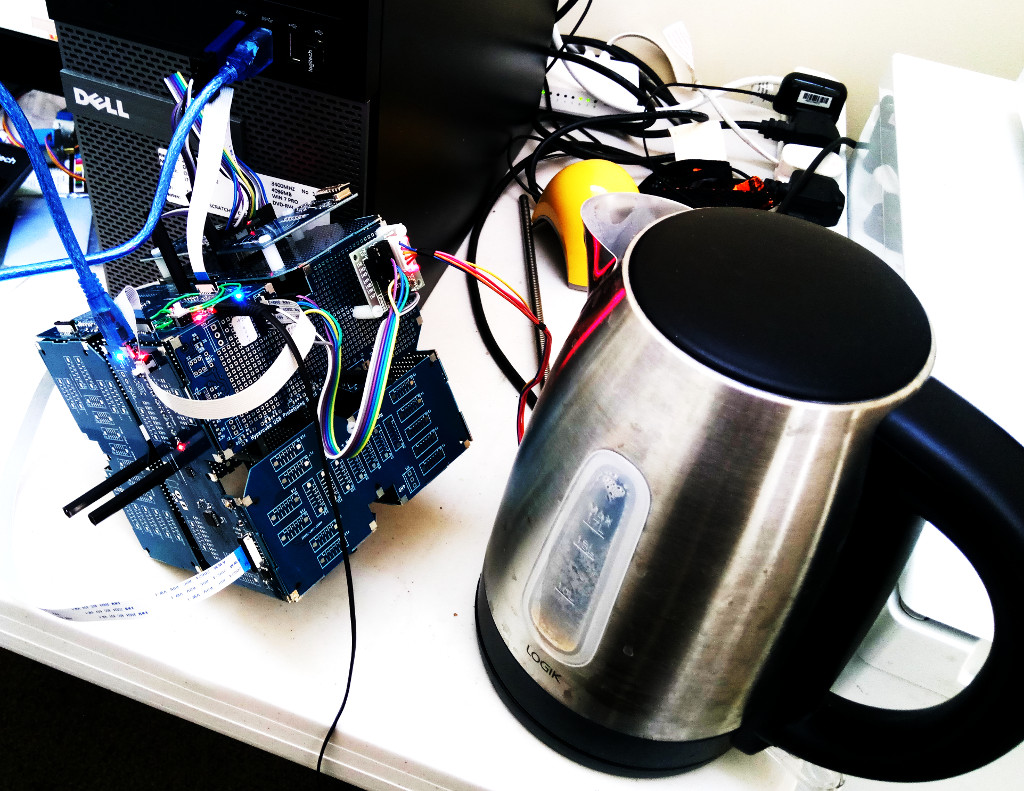|
Home Page
Six Transistor Cache
Investors
Launch Date
Contacts
Terms and Conditions
_________________________
|
Non-Contact Boiling Kettle Detector
Example of rapidly prototyped product using Hypercube - A non-contact boiling kettle detector for Home IoT applications

- The Blue Pill++ board with the MPU-6050 is on the left side of the Hypercube with power fed by blue USB cable. (There are 2 Blue Pill++ boards on this Hypercube.)
- The MPU-6050 has been soldered to the Hypercube board and software activated.
- The vibration data it produces is very clear as the kettle starts to boil and then turns off. Typically the data is first processed to establish average levels for each channel which is subtracted from new values. The remainder is squared (to get rid of negative numbers), summed over a moving average of lets say 10 samples, and then the square root taken. If a threshold is set, then simple vibrations and noise won't trigger the warning, but a consistent rumble will indicate the kettle has been turned on. You would set lets say 1 or 2 minutes for the rumble to last depending on your kettle, and anything above that would signify the kettle has a fault.

- That boil made an excellent brew of tea by the way if you are wondering :)
- There is no electrical contact or connection between something deadly as the boiling kettle and the Hypercube.
- The data gathered is purely vibrations feeding through the table to the MPU-6050 sensor on board the Hypercube STDuino clone board which has been remixed to add in the MPU-6050.
- All done in KiCAD and soon to be released as open source KiCAD schematic file and the software with the MPU-6050 code re-mastered to be fully multi-tasking to be compatible with Hypercube software requirements.
- The sensor data for the accelerometer (and surprisingly the giro sensor) show clearly the kettle coming into boil and then turning off.
- Typical applications include safety device around the kitchen tables and/or connecting walls to detect boiling kettles that may not be turning off in time. This can happen while if the kettle thermal sensor is failing, or the electrical switch is jamming, or if the kettle cover is not shut properly. Merely by noting it is taking too long, a signal could be sent by RS232 to shout out that there is a problem in the kitchen (similar to the speech synthesizer devices described before). Good for Home IoT projects.
- Another use is to combine with RFID door opening sensor and then the board can warn if the door is being forced. If the door is forced open or banged, then it will detect the attempt immediately. This also applies to doors and passage ways that may not have locks but which should not be used without permission. If people have wandered off into restricted areas, the floor vibrations, and doors rotating can be sensed to warn security who can then look at the camera to see what is going on. Other sensors could work equally well, but this type of sensor can measure more complex features of the vibrations such as gait to indicate if someone is running down the passage way.
- Another use is in helping monitor the elderly. This sensor is totally non-invasive but as powerful as detecting boiling kettles with the non-contact method described. Big sounds and vibrations traveling through the floorboard require immediate attention because someone may have fallen or dropped something. Even if it is a false alarm, it is always best to sense the signal and to check it immediately. Typically these would be fitted in bedrooms, bathrooms, toilets, stairs and hallways.
- Another use is in monitoring in a non-invasive way the elderly, especially someone with Alzheimers to create Big Data. Typically the brain is suffering from degeneration, and it starts to do the most unexpected things. We need to know what is changing in a person. It could be number of times they make tea, or it could be the number of times they get in and out of bed, or it could be number of times they visit a toilet, and relate that to progression of disease with a view to changing medication or lifestyle to measure again the progress made with the changes. Using small near invisible sensors, it leads collection of easy to validate physical data to justify treatment, and leads to the understanding of the benefits of different methods of deploying those treatments to specify best practice. Vibration sensors are completely blind and totally non-invasive. So these sensors can be fitted everywhere and the data can be processed into ready made data sets for researchers without identifying or embarrassing anyone.
- In combination with other sensors, this type of vibration sensor helps monitor health of machines. When vibrations are beginning to plague a machine, particularly if its hidden in noise, then through statistical averaging methods, the evidence is collected for maintenance work to be carried out.
- A video here with RS232 streamed data that speaks message on detection of boiling kettle. https://youtu.be/qVgrtxJmEtA
|


